| Listing 1 - 10 of 11 | << page >> |
Sort by
|
Book
ISBN: 3893362770 Year: 2000 Publisher: Jülich Forschungszentrum Jülich
Abstract | Keywords | Export | Availability | Bookmark
 Loading...
Loading...Choose an application
- Reference Manager
- EndNote
- RefWorks (Direct export to RefWorks)
High temperature chemistry --- Materials at high temperatures
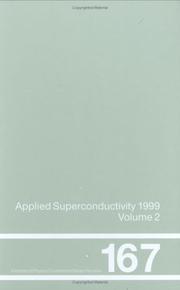
ISBN: 0750306947 Year: 2000 Publisher: Philadelphia, PA : Institute of Physics Pub.,
Abstract | Keywords | Export | Availability | Bookmark
 Loading...
Loading...Choose an application
- Reference Manager
- EndNote
- RefWorks (Direct export to RefWorks)
High temperature superconductors --- Microwave devices --- Superconductors --- Thin film devices
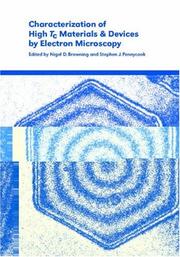
ISBN: 1107113016 1280417013 9786610417018 0511175078 0511039662 0511155174 0511328664 0511534825 0511053398 9780511039669 9780511534829 9780511038150 0511038151 6610417016 9780511053399 052155490X 9780521554909 9781107113015 9781280417016 9780511175077 9780511155178 9780511328664 9780521031707 0521031702 Year: 2000 Publisher: Cambridge ; New York : Cambridge University Press,
Abstract | Keywords | Export | Availability | Bookmark
 Loading...
Loading...Choose an application
- Reference Manager
- EndNote
- RefWorks (Direct export to RefWorks)
This is a clear account of the application of electron-based microscopies to the study of high-Tc superconductors. Written by leading experts, this compilation provides a comprehensive review of scanning electron microscopy, transmission electron microscopy and scanning transmission electron microscopy, together with details of each technique and its applications. Introductory chapters cover the basics of high-resolution transmission electron microscopy, including a chapter devoted to specimen preparation techniques, and microanalysis by scanning transmission electron microscopy. Ensuing chapters examine identification of superconducting compounds, imaging of superconducting properties by low-temperature scanning electron microscopy, imaging of vortices by electron holography and electronic structure determination by electron energy loss spectroscopy. The use of scanning tunnelling microscopy for exploring surface morphology, growth processes and the mapping of superconducting carrier distributions is discussed. Final chapters consider applications of electron microscopy to the analysis of grain boundaries, thin films and device structures. Detailed references are included.
High temperature superconductors. --- Electron microscopy --- Electron microscopes --- Materials at low temperatures --- Superconductors --- Technique. --- Technique
Book
Year: 2000 Publisher: Cleveland, Ohio : National Aeronautics and Space Administration, Glenn Research Center,
Abstract | Keywords | Export | Availability | Bookmark
 Loading...
Loading...Choose an application
- Reference Manager
- EndNote
- RefWorks (Direct export to RefWorks)
Rare earth elements. --- High temperature. --- Optical measuring instruments. --- Sensors. --- Mathematical models.
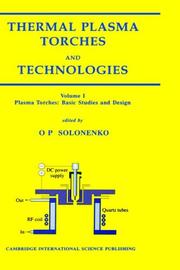
ISBN: 1280500662 9786610500666 1423724224 9781423724223 9781280500664 1898326592 9781898326595 1898326606 9781898326601 Year: 2000 Publisher: Cambridge : Cambridge International Science,
Abstract | Keywords | Export | Availability | Bookmark
 Loading...
Loading...Choose an application
- Reference Manager
- EndNote
- RefWorks (Direct export to RefWorks)
High temperature plasmas. --- Plasma engineering. --- Plasma jets. --- Jets, Plasma --- Plasma torch --- Jets --- Plasma (Ionized gases) --- Plasma accelerators --- Plasma devices --- Plasma rockets --- Engineering --- Hot plasmas --- Plasmas, High temperature --- Gases at high temperatures
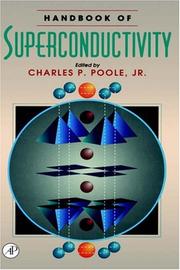
ISBN: 1281054399 9786611054397 0080533213 9780080533216 9780125614603 0125614608 Year: 2000 Publisher: San Diego, CA : Academic Press,
Abstract | Keywords | Export | Availability | Bookmark
 Loading...
Loading...Choose an application
- Reference Manager
- EndNote
- RefWorks (Direct export to RefWorks)
The field of superconductivity has tremendous potential for growth and further development in industrial applications. The subject continues to occupy physicists, chemists, and engineers interested in both the phenomena itself and possible financially viable industrial devices utilizing the physical concepts. For the past five years, within the publications of the American Physical Society, for example, 40%-60% of all articles submitted to major journals in the area of Solid State Physics have been on the subject of superconductivity, including the newer, extremely important subfield of high t
High temperature superconductors --- Superconductivity --- Electric conductivity --- Critical currents --- Superfluidity --- Materials at low temperatures --- Superconductors --- Handbooks, manuals, etc.
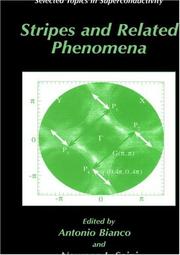
ISBN: 1280608366 9786610608362 0306471000 0306464195 Year: 2000 Publisher: New York, NY : Springer US : Imprint: Springer,
Abstract | Keywords | Export | Availability | Bookmark
 Loading...
Loading...Choose an application
- Reference Manager
- EndNote
- RefWorks (Direct export to RefWorks)
The problem of superconductors has been a central issue in Solid State Physics since 1987. After the discovery of superconductivity (HTSC) in doped perovskites, it was realized that the HTSC appears in an unknown complex electronic phase of c- densed matter. In the early years, all theories of HTSC were focused on the physics of a homogeneous 2D metal with large electron–electron correlations or on a 2D polaron gas. Only after 1990, a novel paradigm started to grow where this 2D metallic phase is described as an inhomogeneous metal. This was the outcome of several experimental evidences of phase separation at low doping. Since 1992, a series of conferences on phase separation were organized to allow scientists to get together to discuss the phase separation and related issues. Following the discovery by the Rome group in 1992 that “the charges move freely mainly in one direction like the water running in the grooves in the corrugated iron foil,” a new scenario to understand superconductivity in the superconductors was open. Because the charges move like rivers, the physics of these materials shifts toward the physics of novel mesoscopic heterostructures and complex electronic solids. Therefore, understanding the striped phases in the perovskites not only provides an opportunity to understand the anomalous metallic state of cuprate superconductors, but also suggests a way to design new materials of technological importance. Indeed, the stripes are becoming a field of general scientific interest.
High temperature superconductors. --- High temperature superconductivity. --- Surfaces (Physics). --- Chemistry, Physical organic. --- Mechanics. --- Characterization and Evaluation of Materials. --- Physical Chemistry. --- Classical Mechanics. --- Classical mechanics --- Newtonian mechanics --- Physics --- Dynamics --- Quantum theory --- Chemistry, Physical organic --- Chemistry, Organic --- Chemistry, Physical and theoretical --- Surface chemistry --- Surfaces (Technology) --- Materials science. --- Physical chemistry. --- Chemistry, Theoretical --- Physical chemistry --- Theoretical chemistry --- Chemistry --- Material science --- Physical sciences
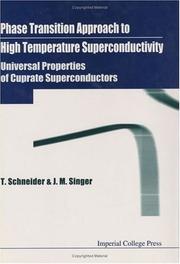
ISBN: 1848160135 9781848160132 1860942415 9781860942419 Year: 2000 Publisher: London : River Edge, NJ : Imperial College Press ; Distributed by World Scientific Pub. Co.,
Abstract | Keywords | Export | Availability | Bookmark
 Loading...
Loading...Choose an application
- Reference Manager
- EndNote
- RefWorks (Direct export to RefWorks)
The discovery of superconductivity at 30 K by Bednorz and Müller in 1986 ignited an explosion of interest in high temperature superconductivity. The initial development rapidly evolved into an intensive worldwide research effort - which still persists after more than a decade - to understand the phenomenon of cuprate superconductivity, to search for ways to raise the transition temperature and to produce materials which have the potential for technological applications. During the past decade of research on this subject, significant progress has been made on both the fundamental science and technological application fronts. A great deal of experimental data is now available on the cuprates, and various properties have been well characterized using high quality single crystals and thin films. Despite this enormous research effort, however, the underlying mechanisms responsible for superconductivity in the cuprates are still open to question. This book offers an understanding from the phase transition point of view, surveys and identifies thermal and quantum fluctuation effects, identifies material-independent universal properties and provides constraints for the microscopic description of the various phenomena. The text is presented in a format suitable for use in a graduate level course.
High temperature superconductivity. --- Copper oxide superconductors. --- Semiconductors. --- Crystalline semiconductors --- Semi-conductors --- Semiconducting materials --- Semiconductor devices --- Crystals --- Electrical engineering --- Electronics --- Solid state electronics --- Superconductors --- High critical temperature superconductivity --- High Tc superconductivity --- Superconductivity --- Materials
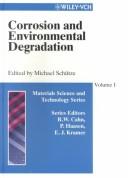
ISBN: 3527295054 3527299718 3527295062 9783527295050 Year: 2000 Volume: 19 Publisher: Weinheim Wiley-VCH
Abstract | Keywords | Export | Availability | Bookmark
 Loading...
Loading...Choose an application
- Reference Manager
- EndNote
- RefWorks (Direct export to RefWorks)
This two-volume reference work belonging to the well renown series Materials Science and Technology provides the reader with a sound and broad survey on the whole subject - from the fundamentals to the latest research results. Written by a team of international top-experts it will become an indispensable reference for any materials scientist, physicist or chemist involved in corrosion science.
Materials --- Environmental degradation. --- Corrosion and anti-corrosives. --- Deterioration. --- Corrosion and anti-corrosives --- Environmental degradation --- Deterioration of materials --- Weathering --- Degradation, Environmental --- Destruction, Environmental --- Deterioration, Environmental --- Environmental destruction --- Environmental deterioration --- Natural disasters --- Environmental quality --- Anti-corrosive paint --- Atmospheric corrosion --- Metal corrosion --- Metals --- Rust --- Rustless coatings --- Chemical inhibitors --- Chemistry, Technical --- Fouling --- Paint --- Protective coatings --- Waterproofing --- Deterioration --- Disintegration --- Corrosion --- Surfaces --- CORROSION --- High - temperature corrosion --- ENVIRONMENT --- Monograph --- STEELS --- Ceramic materials. --- Alloys. --- Oxidation. --- High - temperature oxidation --- Non - ferrous alloys --- Coatings. --- Surface coatings --- Surfaces (Technology) --- Coating processes --- Thin films --- Autoxidation --- Metallic alloys --- Metallic composites --- Phase rule and equilibrium --- Amalgamation --- Microalloying --- Ceramic industries --- Ceramics --- Mines and mineral resources --- Materials - Deterioration.
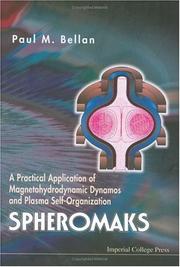
ISBN: 1848160569 9781848160569 1860941419 9781860941412 Year: 2000 Publisher: London : Imperial College Press,
Abstract | Keywords | Export | Availability | Bookmark
 Loading...
Loading...Choose an application
- Reference Manager
- EndNote
- RefWorks (Direct export to RefWorks)
Spheromaks are easily formed, self-organized magnetized plasma configurations that have intrigued plasma physicists for over two decades. Sometimes called magnetic vortices, magnetic smoke rings, or plasmoids, spheromaks first attracted attention as a possible controlled thermonuclear plasma confinement scheme, but are now known to have many other applications.This book begins with a review of the basic concepts of magnetohydrodynamics and toroidal magnetic configurations, then provides a detailed exposition of the 3D topological concepts underlying spheromak physics, namely magnetic helicity,
Plasma confinement. --- Magnetohydrodynamics. --- Magnetic reconnection. --- Annihilation, Magnetic field --- Magnetic field annihilation --- Magnetic field line merging --- Merging, Magnetic field line --- Reconnection, Magnetic --- Reconnection (Astronomy) --- Astrophysics --- Geophysics --- Magnetic fields --- Magneto-hydrodynamics --- MHD (Physics) --- Fluid dynamics --- Plasma dynamics --- Confined plasma --- Confinement of plasma --- Plasma, Confined --- Plasma containment --- Plasma control --- Plasma isolation --- Containerless processing --- Controlled fusion --- High temperature plasmas --- Pinch effect (Physics) --- Plasma confinement --- Magnetohydrodynamics --- Magnetic reconnection
| Listing 1 - 10 of 11 | << page >> |
Sort by
|

 Search
Search Feedback
Feedback About UniCat
About UniCat  Help
Help News
News